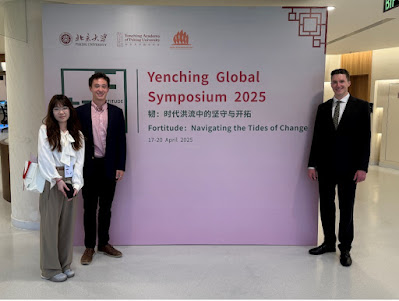Personal Finance with Professor Armstrong-Taylor
This past May, Hopkins-Nanjing Center Professor Paul Armstrong-Taylor held an online lecture on personal finance. HNC certificate’22 student Eljoy summarizes the lessons he learned.
The “Wednesday Morning” newsletter is a tradition that the HNC started to keep students updated on campus-hosted events and other important reminders for the week. They have included interest group discussions, Friday lectures by HNC and non-HNC professors, and virtual meetings with alumni. One such event was an online lecture that HNC Professor Paul Armstrong-Taylor held regarding personal finance. The session introduced some principles for managing borrowing, saving, investment, insurance, and other financial decisions. We live in an era where more and more people are looking for different ways to invest in a financially secure future. Young professionals, including myself, constantly feel the pressure to invest early and not “get left behind.” However, it can be scary to sacrifice some of one’s current wealth without a clear understanding of how investment works. With that in mind, I would like to share what Professor Armstrong-Taylor taught us regarding personal finance.
Professor Armstrong-Taylor divided the lecture into four parts, the first of which covered net wealth. First, net wealth can be divided into assets and debts. For students, applying for a higher education program can be considered in terms of assets and debts. For example, while student debt can be a huge burden for one’s net worth and incur interest, having a graduate degree will also contribute to a higher future earning, which is a crucial part of one’s total asset. More importantly, the goal of personal financing is to minimize risk of sharp falls in net worth while maximizing its long-term growth.
The second part of the lecture discussed risks. Professor Armstrong-Taylor discussed big financial risks that we may face now or in the future, including failing school, health problems, and the inability to work. This discussion led to an important part of the lecture: insurance. Insurance addresses risks and prevents big financial shocks. For this reason, people should pay attention to the insurance policy options that their company may provide. For example, employers in the US may provide free or subsidized options for disability, health, and life insurance. In other words, insurance policy is an important part of a company’s total compensation package.
Another useful piece of information was the discussion of insurance terms, including premium, deductible, co-pay, and max out-of-pocket cost. Premium refers to what one pays to the insurance company per period (typically month or year). Deductible is the amount one pays before the insurance company starts to help with payment. Co-pay is the fraction of the cost one pays after deductible. Max out-of-pocket cost is the maximum amount one pays during a period. Professor Armstrong-Taylor suggested to focus on insurance with a higher deductible. By willing to accept a higher deductible, you will reduce the premium, which means that those who do not often need to use their insurance policy will pay less in the long run.
For a novice such as myself, the third part of the lecture was the most useful, as it discussed how to grow one’s net wealth. First, Professor Armstrong-Taylor introduced us to something known as the wealth effect and income effect. He concluded that paying off one’s debt is often better than saving it to invest. He also discussed the non-financial benefits and financial costs of either renting or buying a living space. Next, the professor highlighted the importance of the compound effect. By saving or investing earlier, one will enjoy a greater return of investment during retirement. Along with the compound effect, diversification is just as important. One aspect is to diversify the placement of one’s risks, separating them into cash, bonds, and stocks. While having stocks may result in higher long-term returns, having cash means avoiding some short-term losses that the stock market often experiences. Diversification must also be done across stocks, asset classes, and countries. In general, the professor suggested that spreading one’s investment is better and often leads to a higher return rate. For beginners, he suggested getting familiar with index funds, and exchange-traded funds.
To summarize, when thinking of one’s personal finance, one must consider removing risks, eliminating debt, minimizing fees (legally), and diversifying investments. When I asked Professor Armstrong-Taylor when he started investing, he replied that he started young. He noted that he made many mistakes, which was great because he hadn’t made much of an investment yet. In his response, he echoed the lesson he wanted to teach everyone, which is to start thinking about one’s personal finance early and experience small setbacks as a lesson for future growth. The lecture made me more comfortable about walking into the investment world and I could see that others were just as excited to learn as well. I hope this blog makes you a little bit more knowledgeable and interested in exploring options of your own personal finance.




